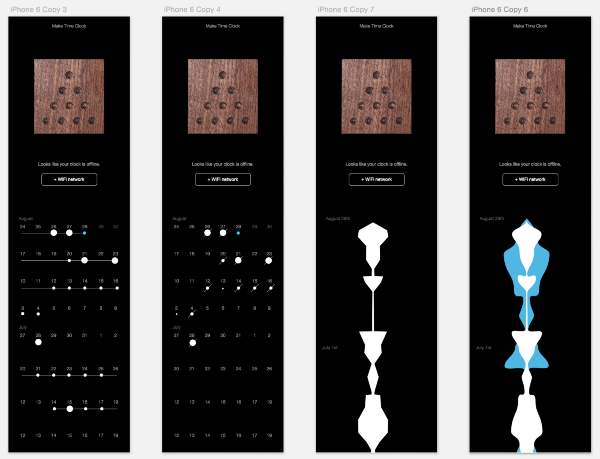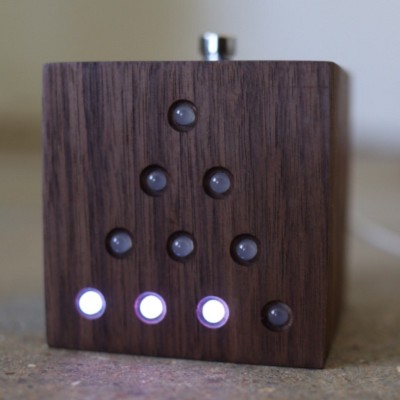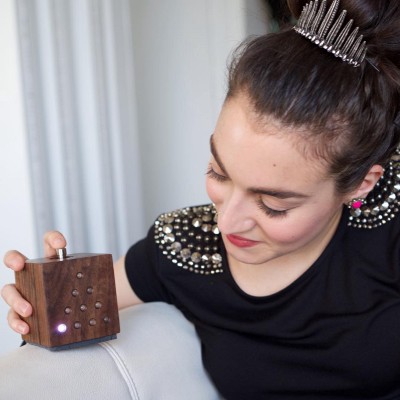a conversation with inventor/maker Chap Ambrose and Executive Director Adam Huttler of Fractured Atlas
It started as a simple idea in Chap Ambrose’s head: a device that encourages people to make time for their creative projects. After creating an early prototype, Chap submitted the idea to Fractured Atlas’s research and development pipeline. For the past few months, a small dedicated team has been working to make the Make Time Clock a reality. Last week, I sat down with Chap and Fractured Atlas founder Adam Huttler to talk about this unlikely and innovative project, and how it came to be:

 From left: Chap Ambrose, Adam Huttler
From left: Chap Ambrose, Adam HuttlerChap: Hi, I’m Chap Ambrose. I’m a UX Engineer at Fractured Atlas and I had the idea for Make Time Clock about a year and a half ago.
Adam: And I’m Adam Huttler. I’m the founder and executive director of Fractured Atlas. Part of my job is to manage Fractured Atlas’s research and development pipeline. In the case of Make Time Clock, that means that I’m keeping track of its progress through various stages of development, and ultimately I’ll have to make the call on whether this is something we want to invest in long term.
So Chap, how did this whole idea start?
Chap: My wife is an artist and I was helping her figure out what she should be spending her time on. There’s so much involved in running any business that the creative part, the fun part, tends to get squeezed out. We hacked together a digital timer with a switch (I had been tinkering with electronics) and she started using it to track her creative time. We were both excited in the subtle shifts in behavior and shared understanding this simple device created.
Adam: Was that the point when you brought it to my attention as a candidate for the R&D pipeline?
Chap: Yes. To me, it was a natural fit for the goals and mission of Fractured Atlas. We’re serving artists and creatives in a lot of ways, but this gives us a chance to help with some of those internal barriers. However, it’s so different than what we’ve done in the past.
Adam, What made you decide to get into hardware?
Adam: First, I want to say I was really excited when you pitched me on the clock. Because we’ve had this pipeline in place for several years now, but that was the first time anyone other than me had proposed something for it. But you’re right, this is a pretty radical departure from the kind of work we’ve done in the past. Even treating it as a sincere experiment required a certain leap of faith. Hardware manufacturing is just a completely different beast than the kind of online services we’ve developed historically. But I decided it was worth exploring for a number of reasons, not least being that this could open up Fractured Atlas to a huge swath of the arts community that isn’t a perfect fit for our existing services, namely “pro-am” artists. If a hardware device is what it takes to do that, then we need to figure out how to make hardware.
It also helped that I have a great deal of confidence in you as the visionary behind this effort. You’ve got this great mix of technical acumen and an extremely human-centered design orientation, which is really quite rare and special. So part of my willingness to take a risk on this was about wanting to see where you’d take it.
You may also remember that probably the first question I asked you was, “Why does this have to be hardware? Can’t this just be an app?”

It is often difficult finding a balance between meeting deadlines and spending time with my family. I want my shop to do well, but I want to go on adventures with my daughter.. I’d like to be in both places at once.”
Chap: Absolutely. I think our phones are incredibly powerful tools, but they can also be incredibly distracting. Most of the creators I know are particular about their environment and seek to remove all interruptions. I envision the clock’s presence as a signal to yourself and your household; this is where creativity happens. One of our early testers realized that their roommates were following their progress on the clock and would change their interactions based on this new piece of data. I don’t think that natural, supportive network would be possible in an app.
I think most of the work we do at Fractured Atlas could be described as “supporting artists”, but how else do you see Make Time Clock fitting into our mission?
Adam: You know, something you said to me a few months back really resonated with me on this point. Fractured Atlas’s mission is about eliminating practical barriers to creative expression. But ultimately, if you’ll forgive a little grandiosity, our goal is maximize humanity’s creative and expressive potential. Make Time Clock is arguably the purest possible expression of that goal.
It tackles the most fundamental, universal barrier there is, which is the psychological hurdle of really committing to your creative work and setting aside the time and energy to develop it.
I believe there’s a huge amount of bottled up creativity out there, including many, many important, unique voices. If Make Time Clock can unlock even a small portion of that, then we’ll have helped to make the world a more creative place, and helped to enrich the overall cultural landscape. How’s that for a burden of expectations?
Chap: Haha, I love it. Blood is pumping.
Adam: Good, so there’s some cardiovascular value to this process as well! But let’s move from the abstract to the concrete for a minute. What is this thing and what does it do?
Chap: The overall goal is to inspire you to make time for your creative projects. The primary interaction is with the physical device, but there is a companion app too.

When you receive the device you are asked to define a single creative project and set a weekly goal of how much time you’d like to spend on it. We’ve found it critical to get folks to focus their efforts.
You place the device in your workspace and essentially “clock in” whenever you’re working on that project. The device’s lights show your progress throughout the week.
We’re exploring some creative prompts and app notifications based on your actions and other signals. We hope to provoke thoughtful reflection about your project and the barriers, rather than feeling guilty you didn’t hit your goal.

Adam: You’re too humble to mention this, but I’d like to point out that the clock is a work of art in itself.
Chap: Thanks :) To me, that’s about respecting an artist space and crafting an object they’re proud to display.
Adam: So for the past few months you’ve been working with a group of beta testers. How’s it going?
Chap: It’s going really well. We really do learn something new with each tester. One theme has been hearing about people personifying their clock. They become attached quickly and have had someone tell me how sad they were when I took their old prototype and upgraded them with a new one.
So we’ve been considering what personality the clock has. And what kind of language it uses and how it adapts to its users to provide encouragement.
Adam: Are you one of the beta testers yourself?

Chap: Yes, I’m currently using a prototype to help me with an app my wife and I are working on. This is a project we’ve been working on for close to a year, so it’s been interesting to see the clock and the app develop side-by-side.
What creative project do you plan on tracking with your MTC?
Adam: Good question! To tell the truth, I haven’t really thought of myself as an artist in many years, but I certainly did at one time. Maybe I need MTC to re-ignite that creative fire.
Chap: You’ve mentioned to me that you don’t see yourself as user of the clock. I think it says a lot about you and the organization that we’ve invested development resources anyways. Can you talk a little bit about that dichotomy and perhaps what excites you about Make Time Clock?
Adam: It’s true that I’m not really the target customer for this product. I’ve never had a shortage of internal motivation, so I haven’t used a lot of tricks or tools to keep me moving forward. I’m also intensely introverted and can be pretty oblivious to my physical environment, so while I can recognize the beauty of an object like the Make Time Clock, it doesn’t energize and focus me like it seems to for a lot of people. Having said all of that, while I’m not completely alone in these respects, I do think I’m something of an outlier. So when you pitched me on the concept of the Make Time Clock, it challenged me to be empathetic with potential users and customers who aren’t like me. Hopefully I’ve been able to do that, at least on an intellectual level, because I do understand how compelling this product is for a lot of people, and why it speaks to them.
The real test, of course, is going to be the Kickstarter campaign. How are you feeling in the lead up to that milestone?
Chap: I’m feeling really good. I gain confidence with every prototype we send to testers. There’s still so much polish that this kind of personal device deserves, but it’s been helpful to remember we’re not shipping the product in November, just launching the campaign :)
Some people weren’t immediately sold on the idea of a Kickstarter launch, but you didn’t seem to need any convincing. Why was that?
Adam: You know, Fractured Atlas is a nonprofit and we spend a lot of time fundraising for our work. The truth is that Kickstarter is a lousy fundraising platform. Sorry if that’s blasphemous, but it’s really a highly transactional platform, which clashes with and does a disservice to the philanthropic paradigm. So I would never do a true fundraising campaign on Kickstarter. On the other hand, it’s a fantastic way to launch a new product. Not only does it help you raise capital without the distractions that can come from the VC-hunt, but it’s also hugely valuable in terms of market signaling. Together, those two elements mean that you can test the market for a new product with minimal upfront investment, confident in the knowledge that if there’s in fact a market for it, you’ll have the capital you need to bring it to that market. That’s exactly what we need for Make Time Clock.
Chap: I think we also would have been more conservative if we weren’t pre-selling on Kickstarter. The stakes would have been higher and I think that pressure would have bled through in the final product.
Adam: That makes a lot of sense. I love that you’ve been uncompromising and unapologetic about the design of the product. There’s almost a whiff of Steve Jobs to it. (Although in fairness you’re more reminiscent of Wozniak!)
Chap: Haha, I’ll take it.
Adam: Nothing wrong with Wozniak. That was a compliment. Wozniak’s a bad ass.
Chap: Absolutely
Adam: Chap, when can we expect to hear more about MTC’s kickstarter launch?
Chap: So we’re launching the Kickstarter campaign in November but in the meantime we’re continuing to refine the design and sending out more prototypes. If you’re interested in helping test a device or want to follow along with the developments you can signup for our mailing list. Also, we just launched our kickstarter to fund the initial production run. So if you want your own Make Time Clock, you can pre-order one here.

